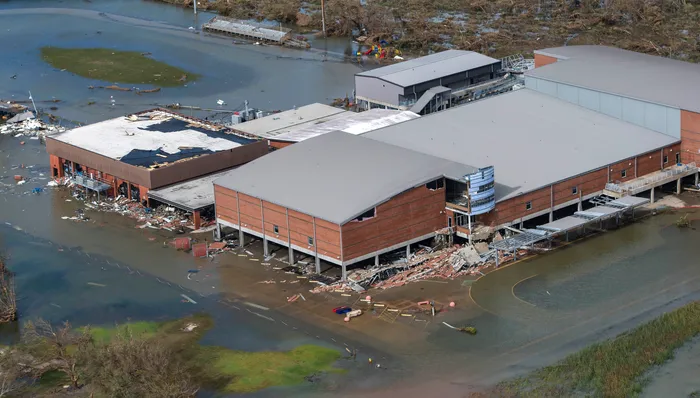Guest post by Jeffrey Peterson
Flooding can damage school buildings and other infrastructure and pose risks to the health of students, teachers, and staff. Even if floodwaters do not reach school facilities, the disruptions that flooding and related storm impacts cause in a community can result in absenteeism and interrupt learning. Unfortunately, climate change is driving more severe storms and intense rainfall. Places that did not flood in the past may be at risk in coming decades. Fortunately, there are steps schools can take to understand and manage flood risks.
Flood Risks to Schools: Severe and Getting Worse
In 2017, the Pew Charitable Trusts released a study of flood risks to schools, finding that “school flooding is distributed widely across the United States” with the greatest risks along the Atlantic coast, Gulf coast, and Mississippi River corridor.
In evaluating relative flood risks, the Pew study identified 100 counties with the highest flood risks and found that there were 6,444 schools serving nearly 4 million students in these counties.
In addition, the study concluded that “even when a school is not located in a flood zone, students who attend it often live within areas of flood risk.” Researchers reported that for some 5,000 schools, half or more of the ZIP code is in a flood zone identified by the Federal Emergency Management Agency.
Floods have always posed a risk to schools, but today a changing climate is making flooding worse in areas that flooded historically as well as expanding the area that is subject to flooding.
In the case of coastal communities, flooding from severe storms results in storm surges that can be up to 15 feet. The Fifth National Climate Assessment (2023) reports that
The severity and risks of coastal hazards across the Nation are increasing (very likely, high confidence), driven by accelerating sea level rise and changing storm patterns, resulting in increased flooding, erosion, and rising groundwater tables. Over the next 30 years (2020–2050), coastal sea levels along the contiguous US coasts are expected to rise about 11 inches (28 cm), or as much as the observed rise over the last 100 years (likely, high confidence).
In the case of schools located inland, a warming climate will result in more intense precipitation and greater flood risks. The climate assessment states that
Since the 1950s, there has been an upward trend in heavy precipitation across the contiguous US….These changes have contributed to increases in river and stream flooding in these regions….There is robust evidence that human-caused warming has contributed to increases in the frequency and severity of the heaviest precipitation events across nearly 70% of the US.
Floods Impact Schools and Learning
Flood impacts on schools and learning fall into several categories:
- Damage to buildings and facilities, including buses, parking areas, sports fields, and playgrounds;
- Threats to the health of students, teachers, and staff during flooding and after the flood is gone (e.g. mold, mental health issues, contaminated water, and dislodged or spilled legacy toxics); and
- Limited access to schools after a flood and the disruption to community services that can cause absences (both students and teachers) and interrupt schedules.
These impacts taken together can result in costly repairs, surprisingly long repair and recovery periods, and significant delays in student progress.
In addition, this story reported that “schools in low-income communities may be disproportionately affected, since they are more likely to be in low-lying areas and have limited access to adaptive technology.” The General Accountability Office found they also have fewer resources to help them recover from natural disasters.
How Schools Can Prepare for Flooding
School systems can reduce flood impacts by both locating new school facilities in places that are as safe from flooding as possible and preparing for flood risks to existing facilities.
In the case of siting and designing new schools, a critical step is to locate facilities outside of flood risk areas, such as the Special Flood Hazard Areas identified by the Federal Emergency Management Agency (FEMA). In addition, the International Building Council (IBC) has just adopted new flood design standards that will apply to schools, hospitals, and related facilities starting in 2027. The standards are expected to result in a “transformative” improvement in resiliency to flood risks. EPA has published guidance on siting new schools but the guidance does not discuss flooding or sea level rise risks or the IBC design standards. EPA should update the school siting guidance to address future flood risks.
For existing buildings, schools can focus on understanding changing flood risks, developing flood mitigation plans, and preparing to recover from a flood as effectively as possible. Some key resources to draw on for this work:
- this paper from the National Clearinghouse for Educational Facilities provides a helpful summary of steps schools can take to prepare for and recover from flooding;
- this paper from the Readiness and Emergency Management for Schools (REMS) Technical Assistance (TA) Center offering a detailed guide to flood management practices; and
- FEMA’s report Making Schools Safe Against Floods provides insights on how government programs can support flood-resilient schools.
As local governments gain appreciation of growing flood risks to schools and other public assets, technical and financial support from the federal government will be more important than ever. Unfortunately, the Trump administration is making significant cuts to key agencies that identify flood risks, help communities prepare for these risks, and respond to disasters after they occur. For example, the president’s proposed budget would make significant cuts to funding for the National Oceanic and Atmospheric Administration, reducing its ability to provide timely warning of storms. At FEMA, the Building Resilient Infrastructure and Infrastructure (BRIC) program, which provided financial support for projects to protect schools and other public infrastructure from flood and related disaster risks, is targeted for elimination.
Given the growing risks from a changing climate and the dramatic cuts to federal government support for disaster preparation and response, schools face an uphill battle in building flood resiliency. Despite these challenges, modest investments in risk assessment and flood preparedness can have significant benefits.
Jeff Peterson is co-facilitator of the Coastal Flood Resilience Project (CFRP) and the author of A New Coast: Strategies for Responding to Devastating Storms and Rising Seas. He has worked for the US Environmental Protection Agency, White House Council on Environmental Quality, and US Senate Environment and Public Works Committee.





